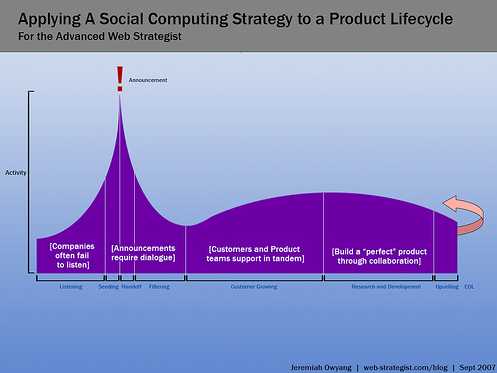Social computing and product lifecycle management

The blogs are full of praise for soon to be minted Forrester analyst Jeremiah Owyang's thought piece about applying social computing to product lifecycle management. While I like the generality of Jeremiah's argument, I'm nervous about applying the ideas in a number of markets. At least for now.
Jeremiah proposes that social computing should be injected into every stage of a product's life from introduction through to retirement as part of the overall marketing effort. On first pass he makes a strong and cogent case designed to maximize value. But let's also be realistic. Product lifecycles frequently stretch over many years. We don't have the experience to know whether Jeremiah's crystal ball gazing will work. A few specifics indicate the challenges ahead:
| Industry | Yes | No | Maybe | Reason |
| Aerospace | X | I don't fancy the crowd making suggestions about the next Boeing/Pratt & Whitney or Google funded moon probe | ||
| Automotive | X | Auto manufacturers might benefit from knowing what customers want but I prefer that car makers design with safety in mind first. Ski racks, water cooler add-ins etc can come later | ||
| Pharmaceutical | X | I like my drugs developed by scientists, not students of Timothy Leary. Having said that, a recent campaign for a weight reducing potion didn't go down well | ||
| Telecomms | X | I want to put this in the 'yes' column but somehow I don't think it will happen without a significant amount of external pressure. Starting with the outrageous pricing charged for roaming | ||
| Enterprise Software | X | Maybe/Yes. SAP believes it knows what customers need. Customers think they know what they want. There's a big difference that SAP is trying to traverse. In the alternative, SAP is working on 'co-creation.' | ||
| Apparel | X | Why do we have a haute-couture fashion industry? As the prelude to high street fashion. Do we want the crowd shaping next year's must have pants? That's why we have houses like Armani and Yves St. Laurent | ||
| Financial services | X | FSI makes its money from dreaming up services we could never think of based on a wide range of parameters including risk, tax policies and economic conditions. While I may not like service (a different issue) I don't fancy the crowd dreaming up my next financial savings plan. |
There are many industries where regulation will prevent the kind of dialog that Jeremiah proposes. Pharmaceuticals is the classic example where FDA rules work against his ideas. Even so, there is no reason why social media cannot be inserted into some of the testing processes as part of a drive towards improved efficiency.
Professional service industries have been engaged with what we now call social computing for years. For example Manpower's Virtual Account Management system has been running since 1999, doing many of the things Jeremiah suggests. In that sense there is nothing new here.
While I think Jeremiah is onto something, there are crucial questions that need answering. At the very highest level, this type of activity is bound to have strategic consequences and companies will need to be comfortable with the ideas suggested. Jeremiah acknowledges this:
Deploying this strategy without grasping the foundations of social media, the cultural changes it implies or testing trial programs will likely lead to failure.
As Susan Scrupski is finding out, large enterprises are some distance from that tipping point:
As I learn more about large organizations, I feel like each CIO I meet transmogrifies into Dr. Phil and says, “Get real, dude. We run a serious company here. We’re not going to put our assets at risk by exposing them to anything beyond our complete control.
From that same CIO perspective, I want to know how these processes get baked into existing systems. To date, I've seen almost no attempt at integrating social computing/media projects into the systems upon which industry depends. That should not be a surprise but it cannot be ignored. I can for example make a case for loosely coupled and ad hoc processes that fit fellow Irregular Rod Boothby's IT Flower model for adding value into processes like PLM but in the real world that has yet to be seen working.
Finally, if Jeremiah's vision is to become reality then you can bet the sun rising tomorrow that IT will be all over this. So far, I've seen nothing that indicates how any of this will be successfully managed. Marketing and IT are not the best of bedfellows and all the talk of skirting around IT will not wash in large enterprises.
